Summary During the month of February, 2012, the veterinary unit in Masai Mara carried out disease surveillance in which 40 buffaloes randomly sampled from different herds were captured and relevant biological samples collected for screening against foot and mouth disease (FMD) and other possible diseases
Summary
During the month of February, 2012, the veterinary unit in Masai Mara carried out disease surveillance in which 40 buffaloes randomly sampled from different herds were captured and relevant biological samples collected for screening against foot and mouth disease (FMD) and other possible diseases. There was also a significant number of elephant injury cases reported across the ecosystem which were also successfully attended to. These cases were related to human-elephant conflict caused by people who always try to repel elephants away from human settlements or farms. The elephants were treated in different parts of Masai Mara including Olare-Orok conservancy, Ngama hills and Talek areas. Last month was marked with a lot of livestock incursions into the reserve searching for pasture and water and this could have contributed to many incidents of human-inflicted wildlife injuries.
Treatment of an adult male elephant with an arrow head stuck on the abdomen in Maasai Mara.
The bull elephant was sighted with a long arrow-head stuck on the left part of its abdomen in Olare Orok conservancy. The elephant was visibly in pain and could not move much due to irritation of the arrow and inflammation. It had made several attempts to pull out the arrow in vain and required urgent veterinary clinical intervention. It was sighted by the Olare-Orok conservancy manager and scouts who reported it to the Mara veterinary unit for attention.
Chemical immobilization and restrain
The elephant was approached to a close distance by a vehicle then darted using 18mgs of etorphine Hcl combined with 1000 i.u of hyaluronidase on the right thigh, the drug took effect after about 10 minutes and it went down on lateral side. Vital physiological parameters such as respiration rate and body temperatures were monitored very closely to ensure that the animal was under stable anaesthesia throughout the treatment process.
Examination and treatment
The elephant had a long arrow-head stuck on the left side of the abdomen, the arrow had only penetrated to the subcutaneous level and only a very small wound was formed. After removal of the arrow, the resulting wound was cleaned and further flushed using 10% hydrogen peroxide and finally treated with a tincture of iodine and oxytetracycline spray. The elephant was also treated using long-acting oxytetracycline antibiotic administered intramuscularly, flunixin meglumine and multivitamins.
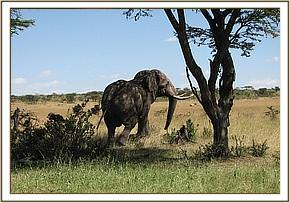
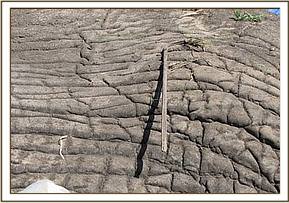
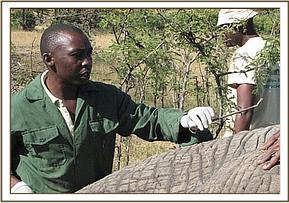
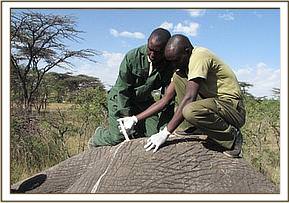

Revival of anaesthesia
The elephant was revived from narcosis using 60mgs of diprenorphine Hcl administered through the superficial ear-veins. The Olare-Orok conservancy manager and scouts were instructed to monitor the animal very closely for some time after treatment and report its progress to the veterinary team. It had a good prognosis and better chances of recovery from the injury after the removal of the arrow-head and treatment.
Treatment of a sub-adult male elephant with traumatic injuries in Masai Mara NR
This was a case of a sub-adult male elephant which had severe traumatic wounds on the left elbow joint. The elephant was found alone in the wild, it could only limp and could not move much in search of food or water. It had been left by the rest of the family since it could note keep pace with the rest. The injury was quite painful and the bull elephant remained on one spot for several hours without much movement. The cause of the injury could not be ascertained but it was suspected to have been cut by a sharp object. The veterinary team managed to capture it and successfully treated it for the injuries.
Chemical immobilization, examination and treatment
The elephant was darted from a vehicle using 5mgs of etorphine Hcl and 1000 i.u hyaluronidase; the drug took effect after about 10 minutes when it went down on the lateral side. The wound was probed carefully using a long forceps and was found to have penetrated up to about 3 inches deep into the muscles. A lot of pus and necrotic tissue debris were squeezed and drained from the wound in an attempt to reduce the swelling and enhance chances of healing. The wound was then cleaned and debrided using 10% hydrogen peroxide and treated using a tincture of iodine and oxytetracycline spray. Further treatments included Betamox antibiotics, multivitamins and dexamethasone which were administered intramuscularly.

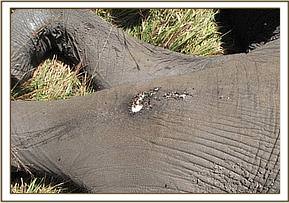
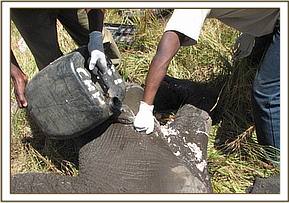
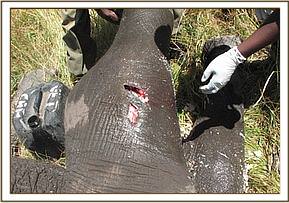
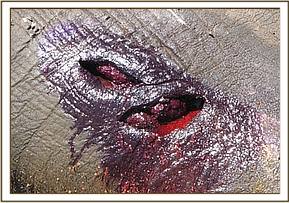
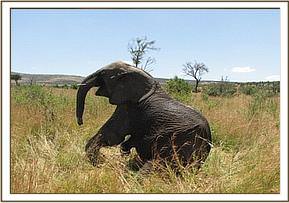

Revival of anaesthesia and prognosis
After treatment the elephant was revived from anaesthesia using 24mgs of diprenorphine hydrochloride administered through the superficial ear-vein. The elephant had a good prognosis after the treatment since the wounds only affected the soft tissues with no bone or joint involvement. It had not developed septiceamia and was treated before the infection advanced. The rangers were advised to keep monitoring and report its progress after treatment, it may require a repeat treatment after two weeks to ensure a quick recovery.
Foot and mouth disease surveillance in Masai Mara NR
The Mara veterinary unit working together with a team from Embakasi FMD laboratory managed to capture 40 buffaloes and collected blood and probang swab samples for FMD analysis. Foot and mouth disease is a highly contagious viral disease of domestic mammals and wildlife, the disease is caused by Aphthovirus, family Picornaviridae viruses and has seven serotypes O, A, C, SAT 1, SAT 2, SAT 3 Asia 1. The disease is still endemic in Kenya with five (O, A, C, SAT 1 and SAT 2) of the seven globally known serotypes prevalent in varying proportions in domestic and wild mammals of Kenya. It is one of the most infectious trans-boundary animal diseases (TADs) that causes major socio-economic losses due to high mortality in young animals, high morbidity, loss of livestock production and most significantly hamper international trade in livestock and animal products. African buffalo (Syncerus caffer) plays an exceptional role as it can be persistently infected and act as maintenance host for the SAT (Southern African Territories) serotypes. Individual buffaloes can carry viruses for up to five years and isolated herds can maintain the infection for more than ten years during which it can be transmitted to livestock. The infection of buffaloes rarely results in clinical signs but persistently infected buffaloes can act as carriers and are able to transmit the virus to other animals, including livestock, when they come into contact, even though the mechanisms of transmission are not well understood. It is therefore important to enhance the understanding of disease spread at the wildlife-livestock interface so as to address concerns about the impact of disease and ensure that appropriate policies and control measures are implemented. Adequate control of FMD will improve livestock production and support healthy ecosystems. This research project will greatly enhance understanding of the current FMD disease situation and the contribution of the wildlife-livestock interface in the epidemiology of the disease.
Chemical immobilization and samples collection
The buffaloes were captured by darting from a vehicle using between 3-5mgs of etorphine hydrochloride 9.8mg/ml (M99, Novartis South Africa Pty Ltd) combined with 30-60mgs of xylazine hydrochloride 10% concentration (Ilium xylazil-100, Troy Laboratories Pty Ltd). These immobilization drugs were loaded into 1.5ml Dan-inject darts fitted with plain Dan-inject needles (N2030, 2.0 x 30mm) and delivered to the animal using Dan-inject remote delivery system (Dart gun). Buffaloes were darted on the thigh muscles and the drug took effect after approximately 5 minutes when the animal became recumbent. Anaesthesia was monitored by observing vital physiological parameters such as respiration rate, body temperature and heart rate. Buffaloes of all ages ranging from young calves of 1 year old to very old buffaloes were captured by darting from a vehicle using Dan-inject dart gun. Whole blood was drawn from the jugular vein using vaccutainer needles into EDTA-coated vaccutainer tubes. Tissue samples, tick samples and any other relevant samples from any disease lesions were collected for laboratory analysis.
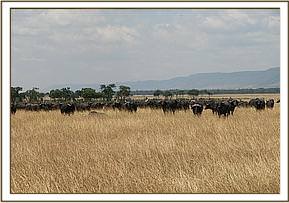

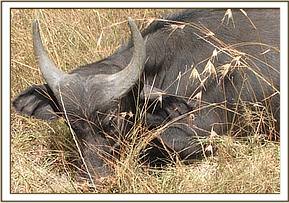
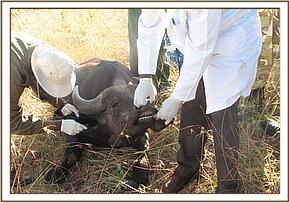
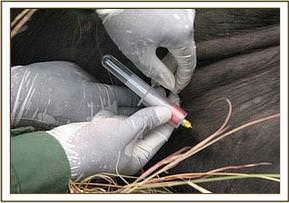
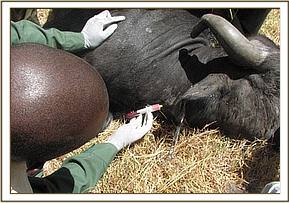
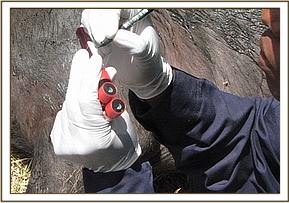

Revival of anaesthesia
After collection of the samples, buffaloes were revived immediately using 24mgs of etorphine Hcl combined with 5mgs atipamezole (Antisedan) or 75mgs of Naltrexone combined with 5mgs of atipamezole. The drugs were administered through the jugular vein and wake-up time was recorded to determine the effectiveness of the different drug combinations. The samples have so far been dispatched to Embakasi FMD laboratory for analysis, but other sets of samples are at KWS veterinary lab in Nairobi for other on-going and new research studies on buffalo diseases.
Treatment of a wounded elephant in Talek area.
This was a case of an adult male elephant which had two deep wounds on the tarsal joint of the left front leg, just above the spool. The wound was already infected with a lot of pus, fluid and necrotic tissue debris accumulation; the elephant could barely walk and it was avoiding much weight on the affected leg. The elephant was sighted just by the roadside and it had suffered from the injury for some days.
Chemical immobilization, examination and treatment
The elephant was found in open grassland from where it was darted using 17mgs of etorphine Hcl combined with 1000 i.u hyaluronidase, the drug took effect after about 6 minutes and it became recumbent. It had a very deep wound penetrating into the tarsal joint; no foreign object was retrieved from the wound. The wound was cleaned with a lot of water and gauze swabs removing all the mud, necrotic tissue debris and pus from the infected site, and then probed carefully using a long forceps to find out if there was a foreign material inside and how deep it penetrated into the tissues but no object was retrieved from the wound. The wound was further flushed and debrided using 10% hydrogen peroxide then treated with a tincture of iodine and oxytetracycline spray. Further treatments by intramuscular administration of long-acting oxytetracycline antibiotics and flunixin meglumine were provided.

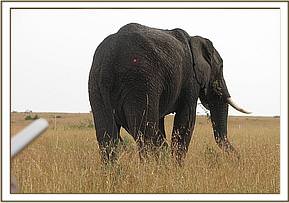
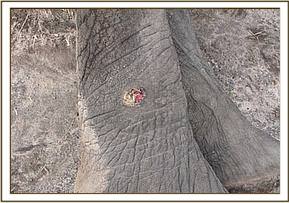

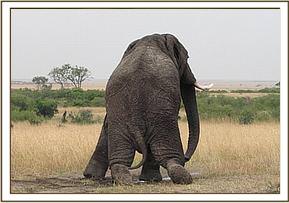

Revival of anaesthesia and prognosis
The elephant was revived from anaesthesia using 48mgs of diprenorphine hydrochloride administered through the superficial ear-vein. The elephant had a good prognosis after the treatment because it had not developed arthritis and was still active with good appetite which will greatly improve its chances of survival.
Acknowledgement
KWS appreciates the great support of the David Sheldrick Wildlife Trust (DSWT) and other partners who have contributed a lot of valuable resources towards the provision of wildlife veterinary services; this has significantly contributed to wildlife conservation in the Masai Mara ecosystem which is currently facing the challenge of human-wildlife conflict, loss of wildlife habitat and neglected zoonotic diseases such as rabies, anthrax, trypanosomiasis and bovine tuberculosis.
Report by: Dr. Domnic Mijele